According to a Statista study, around 15 million US adults relied on generative AI as their primary online search method last year.
That number is expected to triple by 2028. Answer engines are becoming widely adopted, and answer engine optimization (AEO) involves the tactics necessary to have your website appear on these search engines.
Still, AEO is a new concept. Wrapping your head around it might seem intimidating. That's why in this post, I'll walk you through everything you need to know about answer engine optimization—what it is, how it works, why you should focus on it, and how to do it yourself.
What you will learn
- What AEO is and how it works
- Why you should shift from traditional SEO to AEO
- How to optimize for answer engines
What is answer engine optimization (AEO)?
Answer engine optimization is the process of optimizing content for AI-powered search engines like ChatGPT, Perplexity, Bing Copilot, as well as Google's AI Mode and AI Overviews.
AEO can also involve Google search features, like featured snippets and Knowledge Graph, or voice search results across voice assistants like Siri and Google Assistant.
AEO involves creating content that provides direct answers to user queries. This helps your content get picked up and cited in AI-generated answers, which boosts visibility and organic traffic.
Unlike traditional search engine optimization (SEO), which aims to improve a webpage's position on search engine results pages for particular user queries, AEO aims to get your webpage mentioned in AI-generated answers across multiple AI platforms.
Here's what happens if I type in "What are the best hot dog joints in Chicago?" in Google's AI Mode:
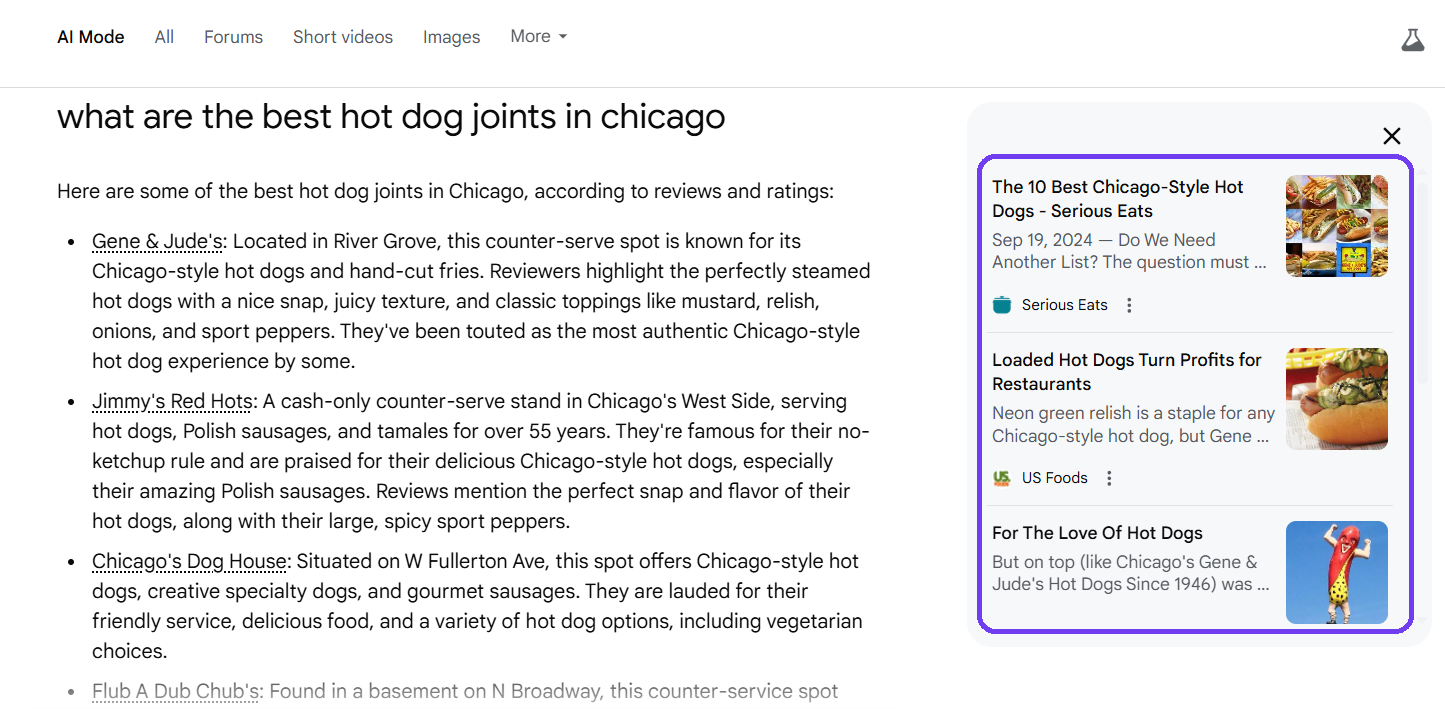
Google provides a detailed list containing some of the top hot dog joints in Chicago. These details are extracted and compiled from multiple pieces of content covering this particular topic.
Google then displays the sources it used to generate answers in the right-hand corner of the screen. The same idea applies to other AI assistants, like Perplexity and ChatGPT.
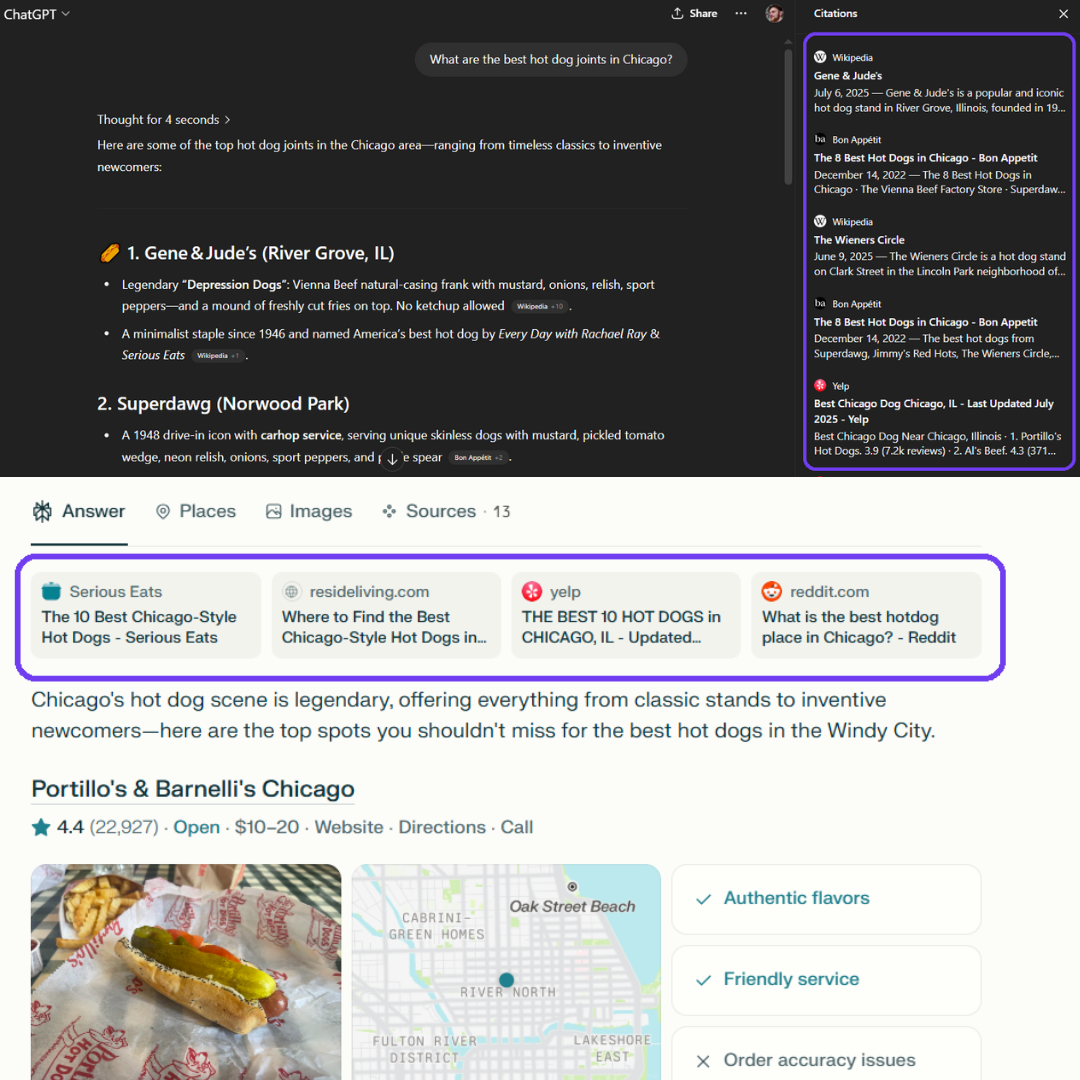
As such, AEO makes it more likely for AI algorithms to extract and mention your content in AI-generated results.
Why is AEO important?
AEO is important because it drives more high-purchase-intent traffic to your website. AI-driven clicks are a strong revenue driver for several companies, including ours.
Approximately 25% of new Surfer customers now originate from AI assistants.
Ahrefs reported similar behaviour.
"For ahrefs.com, 0.5% of visitors in the last month were from AI Search, but those were 12.1% of our signups. This conversion rate is 23x higher than we get from traditional organic search."
— Patrick Stox, Ahrefs Product Advisor, Technical SEO, and Brand Ambassador.
That's huge, especially when considering that the number of users who rely on AI search tools is expected to increase by more than double by 2028.
Unlike traditional search engine optimization—where you would typically target search terms comprised of two or three words—AEO involves much lengthier, more specific search queries.
Users often leverage AI search engines or voice search assistants to get quick answers that would've otherwise been trickier to find via the regular search bar.
This often translates to high-intent, long-tail queries like the one I showed earlier.
Here are a few other reasons why AEO is so important:
Zero-click searches are a rising trend
A SparkToro report found that organic link clicks lowered by almost 4% from March 2024 to March 2025, while searches ending without link clicks rose by around 3%. Zero-click searches are a lot more convenient because they offer instant information—having your webpage provide that instant information is crucial here.
Shifts in search behavior
According to WebFX, over 60% of Millennials and Gen Zers already use AI engines in their search routines. Overlooking AEO will likely cause you to miss out on a significant portion of organic search traffic.
Brand visibility
Google's AIO takes up huge chunks of search engine results pages.
Having your website pop up here will have a major effect on your overall presence.
Plus, simultaneously optimizing content for other AI engines like ChatGPT and Perplexity would be a huge win, visibility-wise.
To put it differently, AEO is absolutely necessary to maintain visibility, generate organic traffic, and boost sales. Your website is at risk of missing out on these benefits, and maybe even losing part of your existing traffic, otherwise.
How AI engines source and cite content
AI search engines scrape massive datasets to train on and extract information from multiple sources across the web.
They then take search queries and use natural language processing to understand their explicit intent and context, and form answers by citing and compiling information from sources most relevant to these queries.
This is done via the retrieval-augmented generation (RAG) technique, an LLM framework that combines traditional retrieval-based systems with generative AI to improve the accuracy and relevance of AI-generated outputs.
RAG allows LLMs to extract information from resources outside their training data, ensuring up-to-date responses. If you remember, ChatGPT could only provide answers with information from up until 2021.
That's because ChatGPT back then was limited to its internal training dataset prior to its 2023 update.
With RAG, however, that's no longer the case. That's why Google's AI Mode is capable of answering queries like "What are the most anticipated movies in 2025?", for example:

As you can see, Google compiled information from recently published blog posts—it looked at resources outside its training datasets.
But how do AI search engines pick the resources to extract information from?
Website authority plays a major role here. AIs prioritize websites they deem as highly authoritative and trustworthy in their niche.
Case in point, the answer above was compiled from industry giants like IMDb, Rotten Tomatoes, and Variety.
7 ways to optimize for answer engine results
The good news, it's not mandatory to be a huge industry authority to make it to AI results. The tips and tricks I'm about to show you will also boost the chances of having your content show up in AI search engines.
1. Write conversational summaries
You want to make it as easy as possible for AI algorithms to scan your content and extract information from it. That means you should provide direct answers, ideally through a short one or two-sentence summary, before you get into details.
To illustrate, here's what happens if I type in "How to set up out of office in Outlook?":

The answer is made out of three simple sentences—no need for fluffy intros and lengthy blog posts. Both AIs and users want direct, digestible answers, so your content should follow a similar format.
Use active voice and write subject-first sentences, like "You can set up out-of-office messages by…," for example.
This approach also helps AI search engines better understand each sentence's context and make it more likely for your content to get cited.
Of course, that doesn't mean your blog posts should take up a few sentences. But you can follow Google's fan-out technique—provide concise answers right at the beginning, then expand on them whenever needed.
The example above is actually just a snippet of a much more in-depth answer. Users can click on the Show More button to view the answer in full.
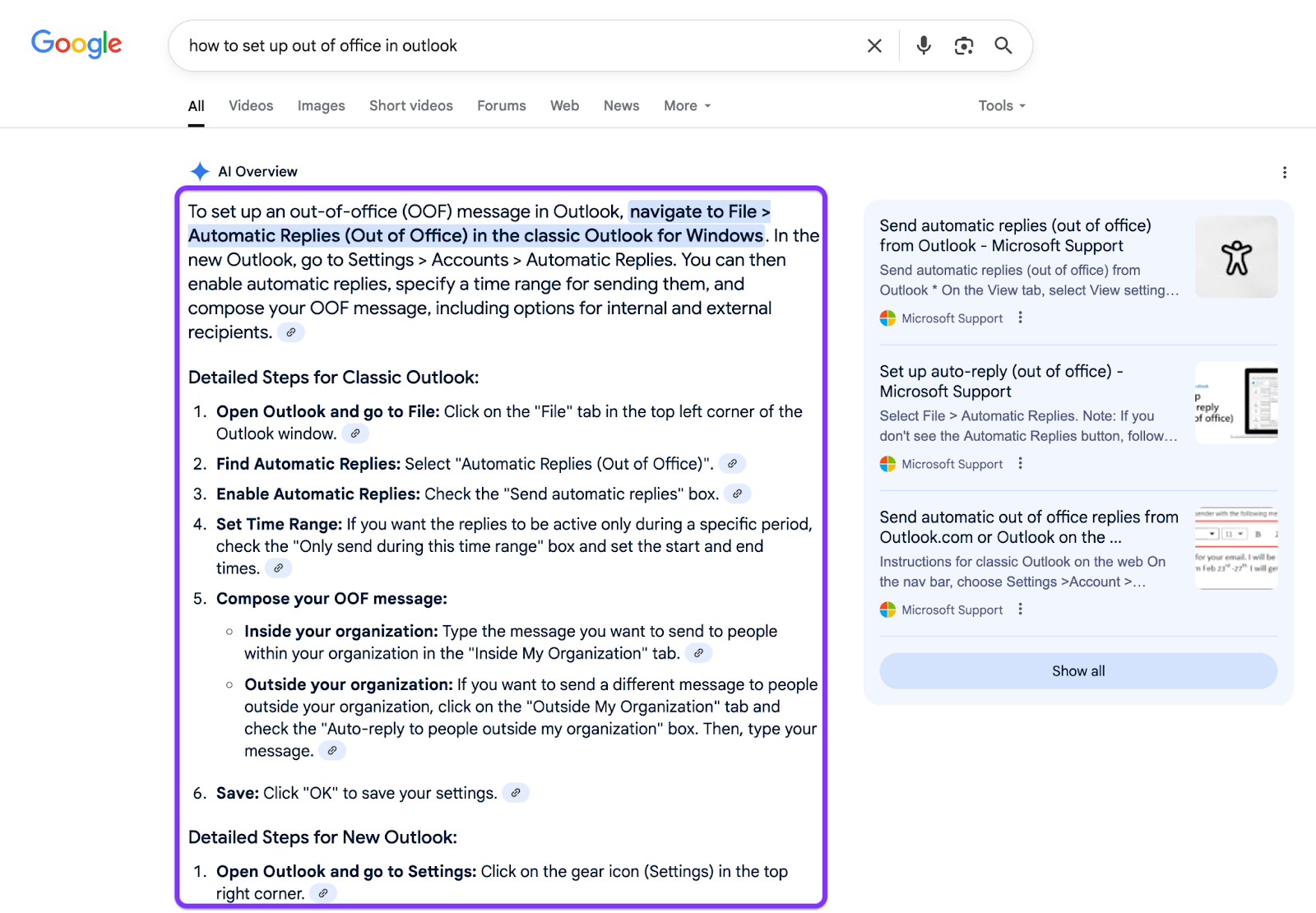
Notice how the top summary is neatly split into two parts—the new Outlook and the classic Outlook. The top summary covers both versions in a few sentences.
If users want more information, however, the answer beneath is split into two distinct sub-sections, each getting into more details.
Use an AI tracking tool to identify your brand's visibility for important prompts. Optimize answers for prompts that you're not showing up for.
For example, using Surfer AI Tracker, you can see Philip's visibility in the AI healthcare space. Their visibility and mention scores aren't very high.
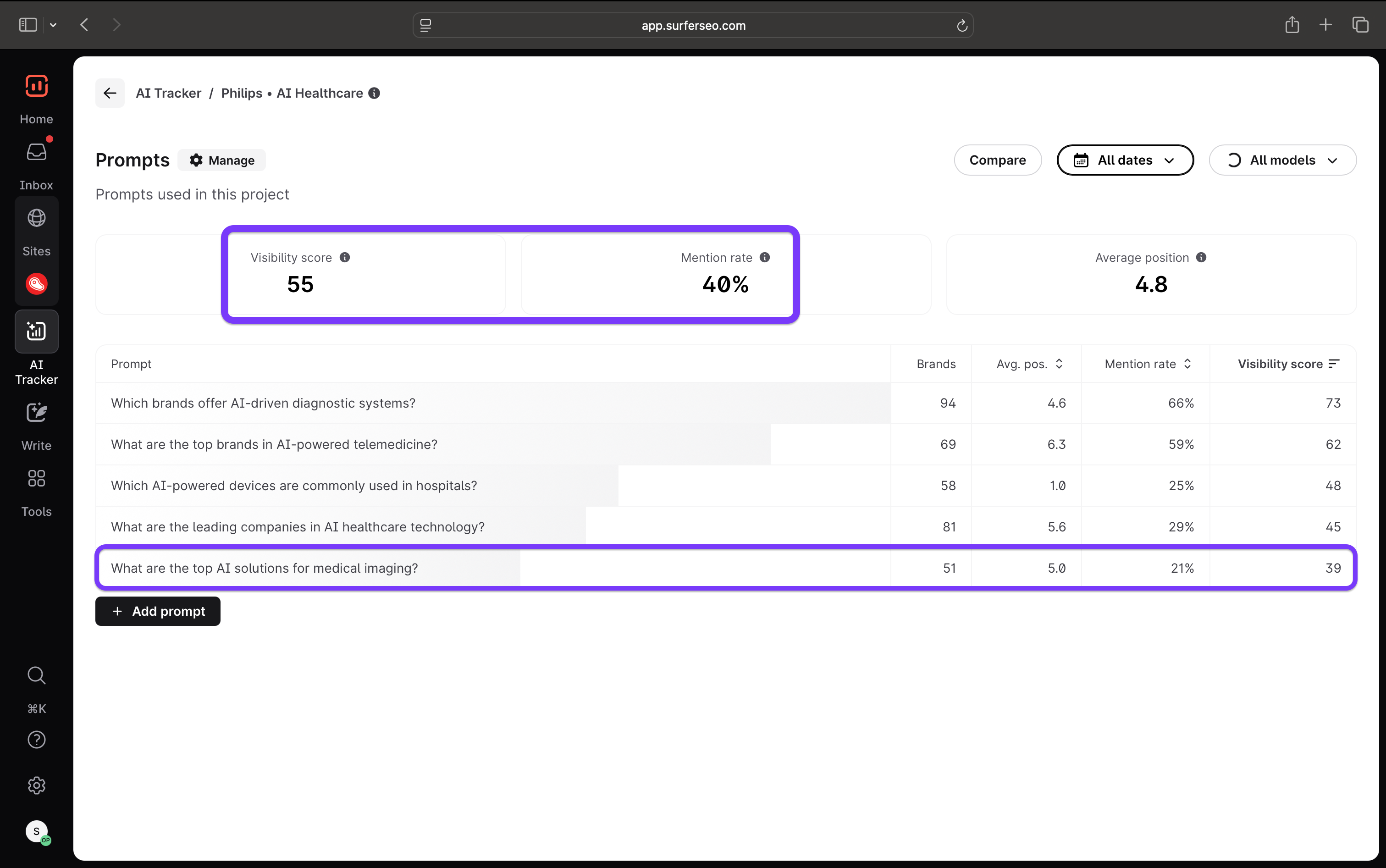
In fact, you can see that they're only mentioned 21% of the time someone searches for "What are the top AI solutions for medical imaging?"
That's a poor mention rate that could be very relevant for their healthcare business. Showing up more would mean higher brand awareness and potential revenue.
Using Surfer, they could study other brands and competitors with higher visibility scores.
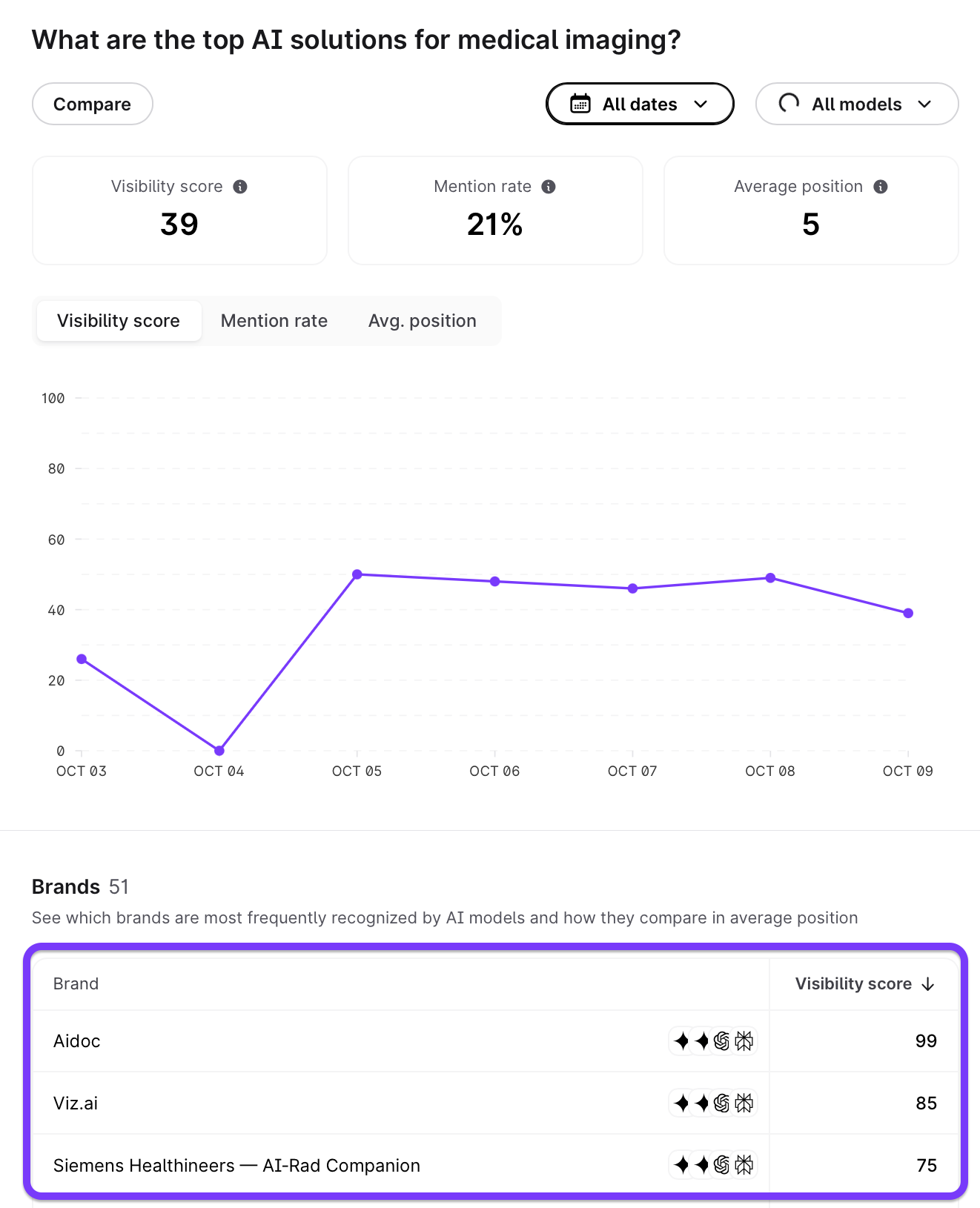
Doing so could help them implement LLM optimization tactics to improve their AI visibility.
2. Use LLM-friendly formatting
Our study on AI Overviews found that AI-generated answers include either unordered or ordered lists 78% of the time, which makes sense.
Lists are the ideal format for zero-click searches—they display large amounts of information in a clear, digestible manner.
Your content should follow suit. Break up your content into lists, bullet points, and tables to make it as scannable as possible.
This blog post from Healthline is an excellent example:
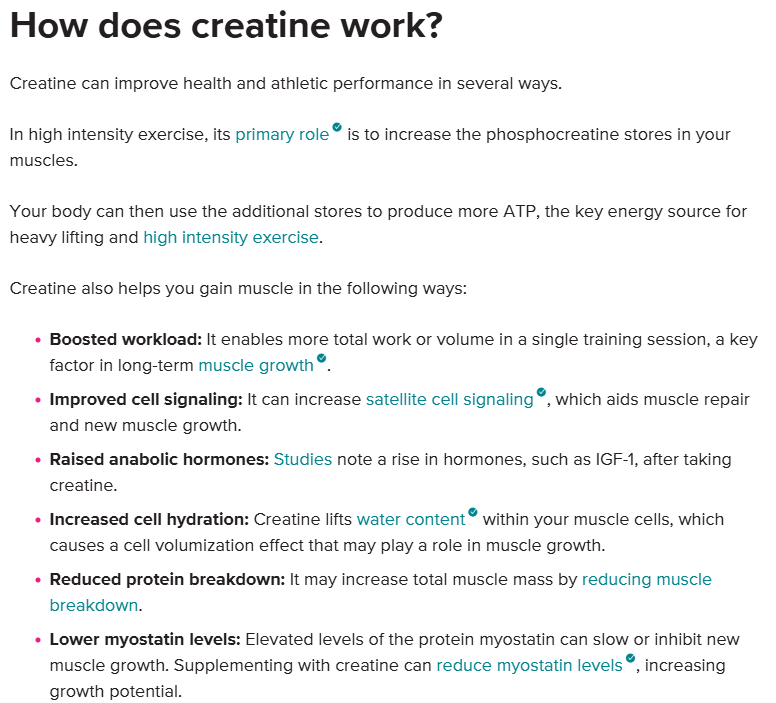
Each idea is neatly summarized under its own bullet point, making it easier for AI-driven search engines to extract particular details.
Here are a few other best practices you can pull from this blog post:
- Write short, decisive paragraphs: Aim for two or three sentences per paragraph and ideally keep your sentences under 20 words. Focus on declarative statements to provide authoritative and direct answers to readers.
- Avoid vague headings: AIs and traditional search engines rely on headings to understand content. Headings should be specific and summarize the ideas beneath them—think "How does creatine affect muscle growth?", for example.
It's more direct and specific than "Creatine benefits." This also helps answer engines better connect user queries with your content. - Include semantic cues: Start sentences with phrases like "According to," "the most important," or "by comparison," when appropriate. This helps AIs understand each sentence's purpose and context.
3. Use clear and descriptive subheadings for easy navigation
Speaking of headings, make sure you break your content down into H2s and H3s.
One of our internal studies on AI Overview answers revealed that pages in AI Overview results score 19.95% better on subheadings and navigation structures than non-included pages.

That means the more structured and scannable your content is, the more likely it is to have it picked up by answer engines. Crystal-clear headings and subheadings are excellent for achieving that.
Again, avoid vague headings. Your headers should clearly encapsulate each of your content's discussion points, while the copy below them should build on your ideas in two to five paragraphs.
Use nested headings to divide your main topic into multiple secondary discussion points in a logical and hierarchical manner.
H1s highlight your content's main idea, H2s present its related subtopics, H3s further develop on the said subtopics, and so on.
You want users and AIs to summarize the bulk of your content just by looking at the headings.
Here's how Grammarly does it:
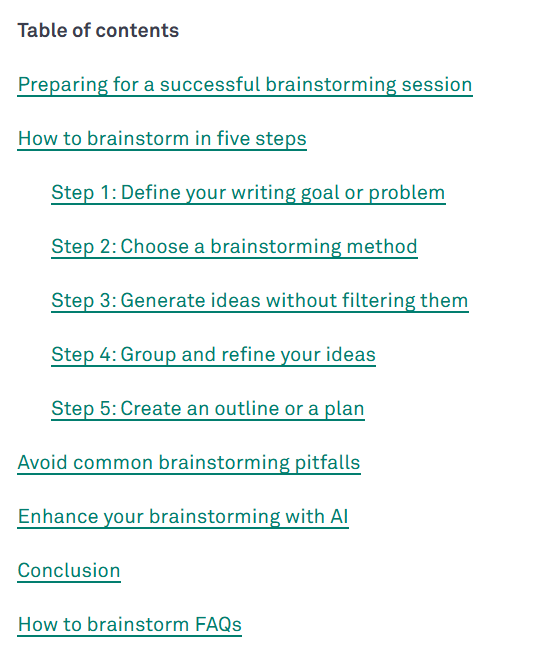
This particular blog post is titled "How to Brainstorm: 5 Simple Steps for Stronger, More Organized Writing." The title is clear-cut. Readers know exactly what to expect from the content through the page title alone.
Each H2 and H3 then breaks the page title down into separate talking points in a logical, hierarchical order—from how to prepare for a brainstorming session, to conducting the brainstorm itself, common mistakes you should avoid, etc.
All subheadings neatly tie back into the blog post's main idea.
Consider adding a Table of Contents plugin or anchor links to your blog pages, similar to the example above. This helps with reader navigation and may help with LLM parsing.
4. Define concepts clearly and explain their relationships
Begin new sections by clearly defining the key terms you will talk about in detail. The same study I mentioned found that pages adopting this practice score 17.46% better on AIOs than those that don't.

If you were to write a section about a complex topic, like how to perform a technical SEO audit, you should first start by explaining what technical SEO audits actually are or what they do—just like what AIO does here:
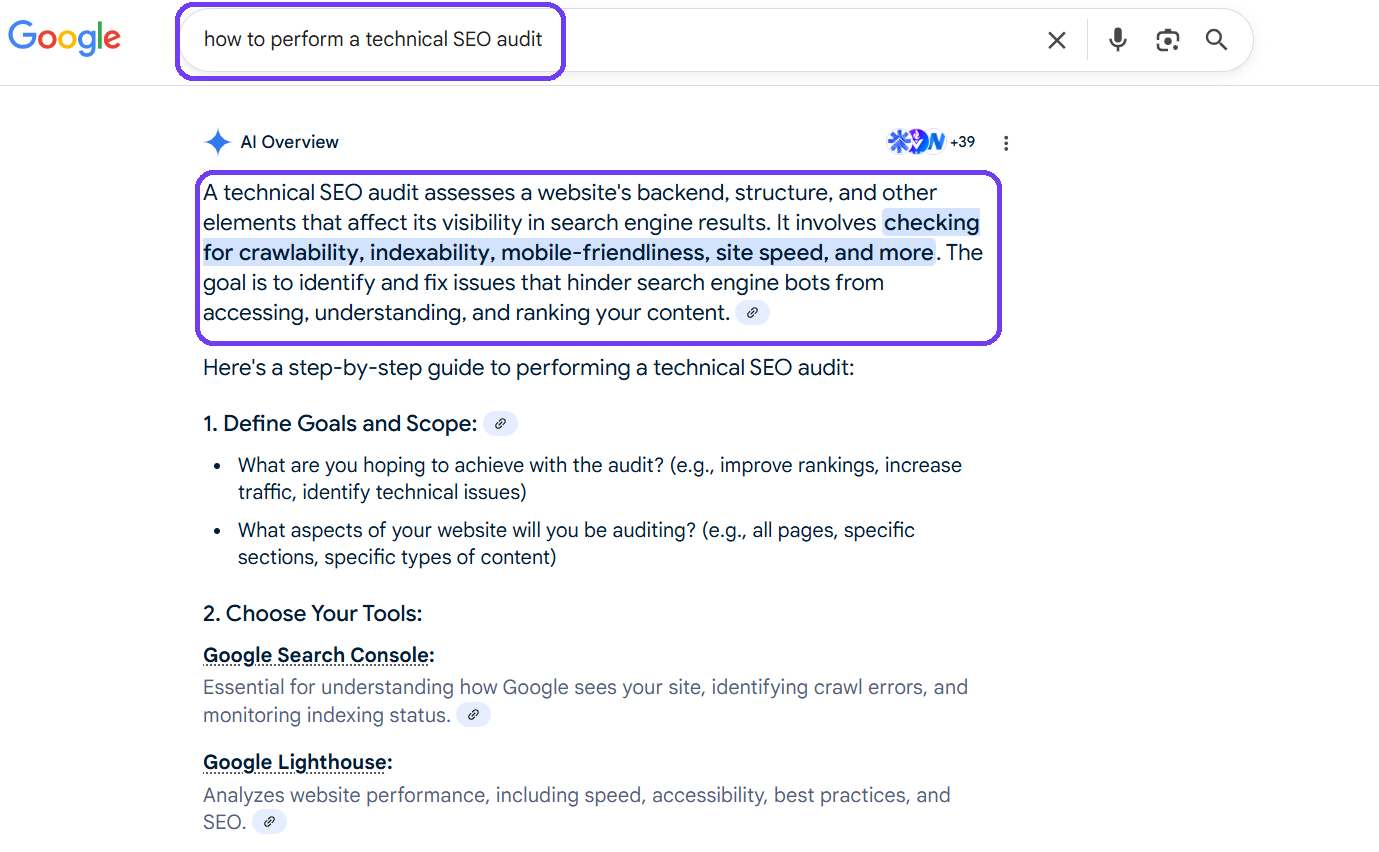
Don't assume readers are already familiar with the topic in question because some might not be. Plus, this practice gives search engines extra context behind your content's main and secondary topics.
Use semantically related terms to bolster this effect.
For instance, if "technical SEO audits" is the primary keyword, you should also include other related terms like "crawlability," "site speed," and "site structure."
But include these terms naturally throughout your content and build up enough context to make sure AI algorithms, regular crawlers, and readers clearly understand how all these terms relate to one another.
Linking phrases like "for example," "in contrast," and "as a result" also help improve clarity and hint to search engines how different paragraphs correlate with each other.
5. Align structured data with visible content
Although more closely associated with traditional SEO, structured data (or schema markups) can still help with answer engine optimisation, as per Google's guidelines.
In short, these HTML code snippets use pre-defined tags to signal to search engines the exact type of content a webpage covers.
AI platforms can also use structured data markups to find and extract information about your business or web page more easily.
Here's the schema markup of a blog post that includes a small FAQ section near the bottom:
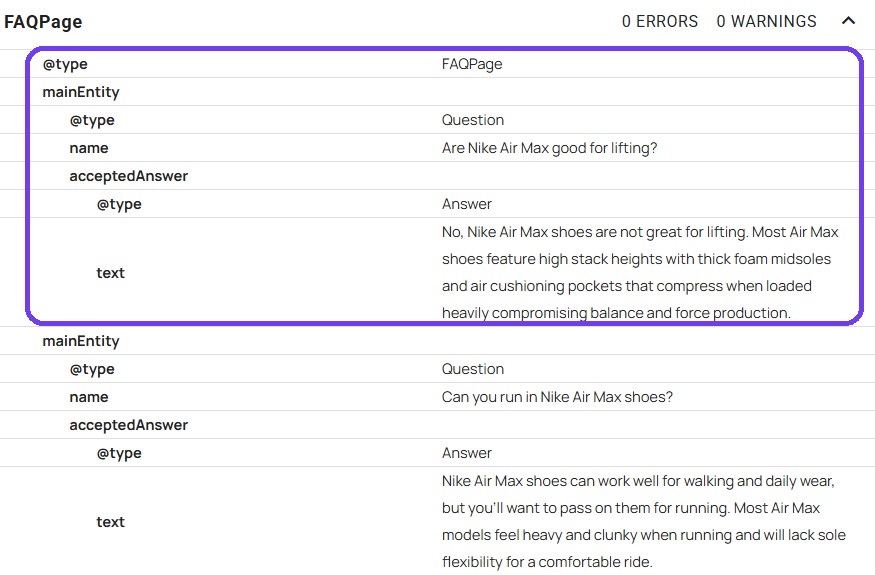
Each question and answer within the FAQ section is clearly highlighted via the @type Question and @type Answer labels under the FAQPage schema markup.
Here's what the FAQ section looks like on the live blog post:
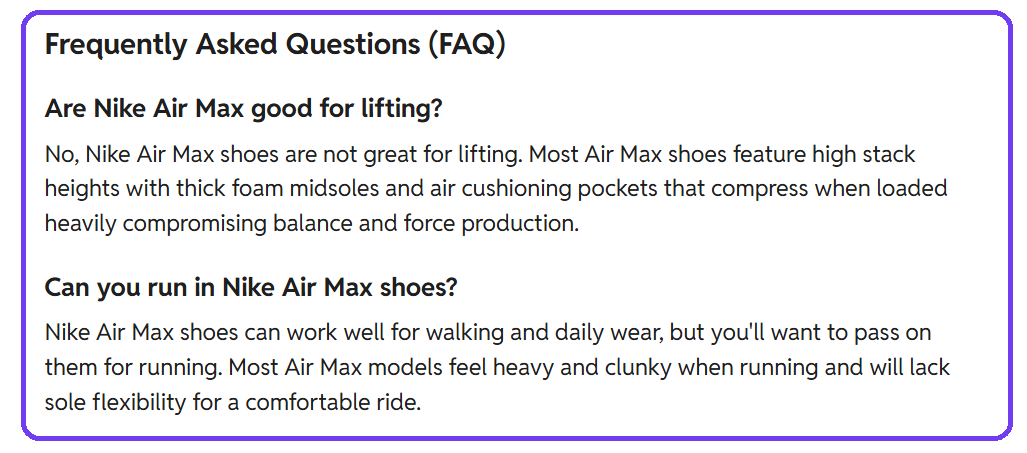
Notice how the FAQ copy is an exact match with the one written in the Schema markup. And here's what happens if I Google "Are Nike Air Max good for lifting?"
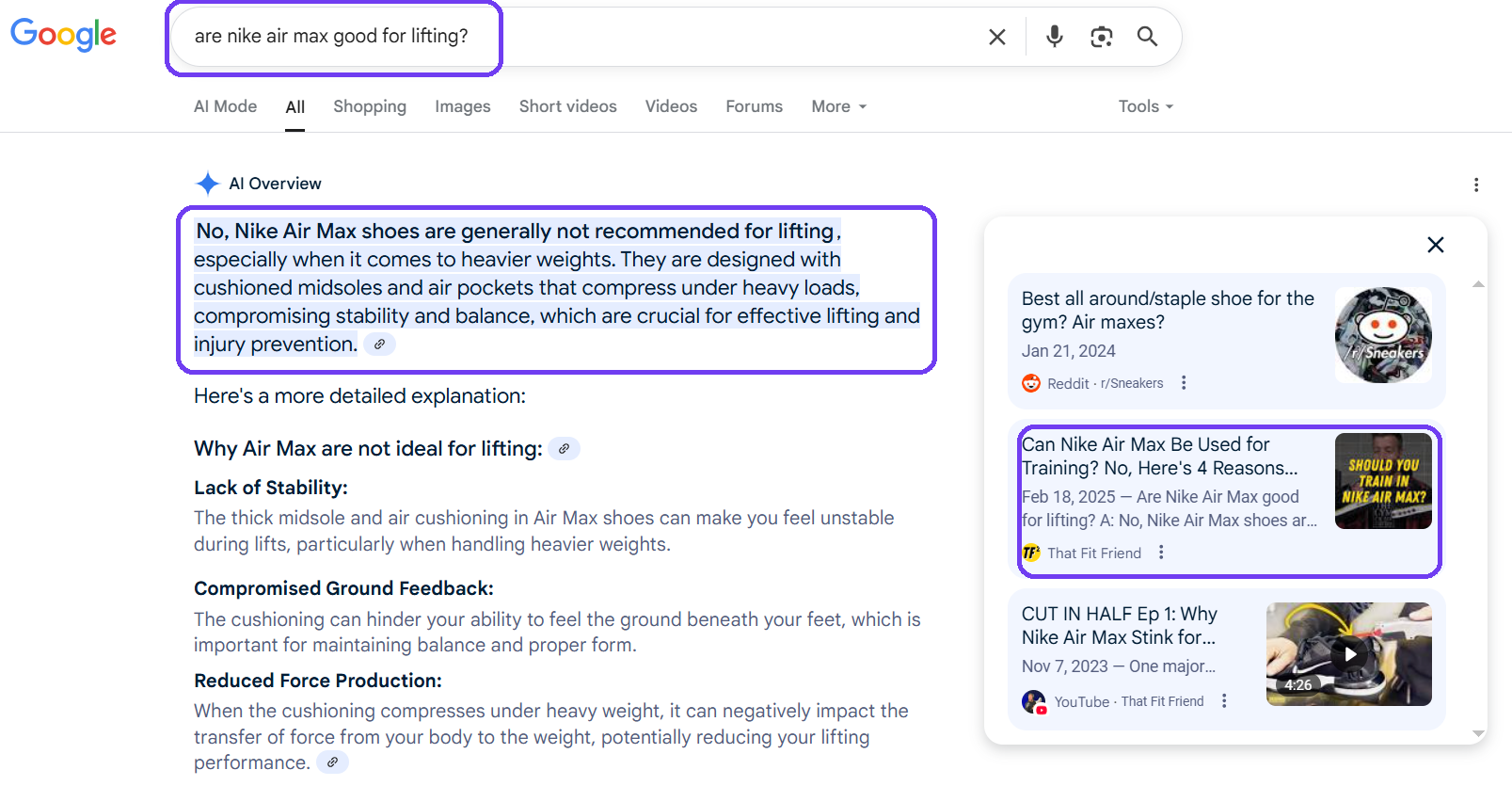
Google AIO pulled info from the blog post's FAQ section—the structured data most likely helped here.
Still, make sure you keep all your information consistent. The details highlighted in your site's structured data must align with what users see live on your webpage because search engines use consistency as a trust signal.
You may risk being treated as an unreliable source of information otherwise.
Here are a few other best practices to follow:
- Validate structured data: Run your Schema through Rich Results Test or Schema Markup Validator before uploading it to your site to ensure the code works as intended.
- Use schema only when appropriate: Only use markups when your content can truly facilitate this format to avoid trust-related issues from search engines. Here's a list of some popular Schemas and when to use them.
- Use JSON-LD formats: Microdata and RDFa schema formats are also available, but Google recommends sticking to JSON-LD—it's easier to maintain and implement.
6. Use questions in your headers
Due to AI models' conversational nature, AI search queries also tend to be question-based. That means AI algorithms will prioritize content that facilitates this format when extracting information.
Again, AIs will look at your headings to understand your content and its structure.
As such, question-based headings that mimic AI search queries will make it easier for AIs to match your content and cite your answers whenever users look up particular details.
Remember that the copy beneath your headings should provide short and precise answers. Here's a solid example:

You can develop on this concept and answer secondary questions related to the main query in a FAQ/Q&A-style blog post.
To better illustrate, this SySTools post has formatted most of its headers to simulate natural AI search queries:
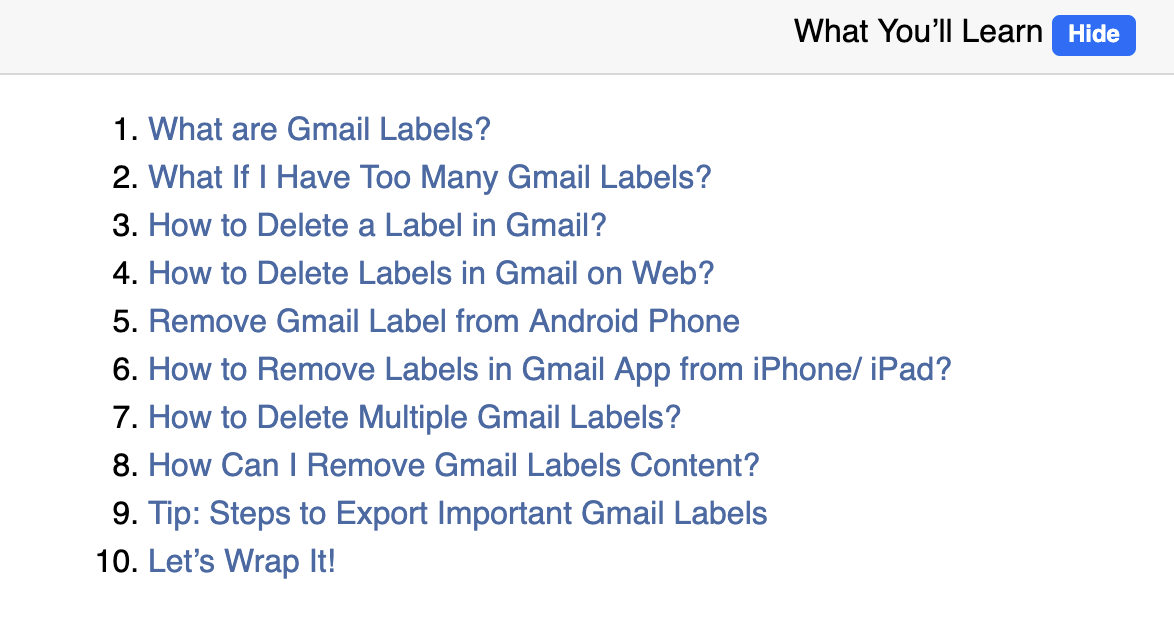
You can also add dedicated FAQ or Q&A schema markups under each particular section whenever appropriate.
7. Experiment with text fragment identifiers
Text fragment identifiers are URL string parts that link to particular snippets of text within a webpage. Here's what it looks like in practice:

The underlined part of the URL leads to the text fragment highlighted in purple.
Although it's not 100% confirmed whether this tactic helps with answer engine optimization, it's worth giving it a shot—experiment with it and see if it brings results.
The idea behind it is that text fragment identifiers enhance user experience by helping readers access particular web page segments quickly.
As such, it would also help AIs identify and match specific content sections with user queries.
Plus, most CMS solutions can automatically generate text fragments identifiers for your web page content. So, you might make it to AI-generated answers without much extra effort.
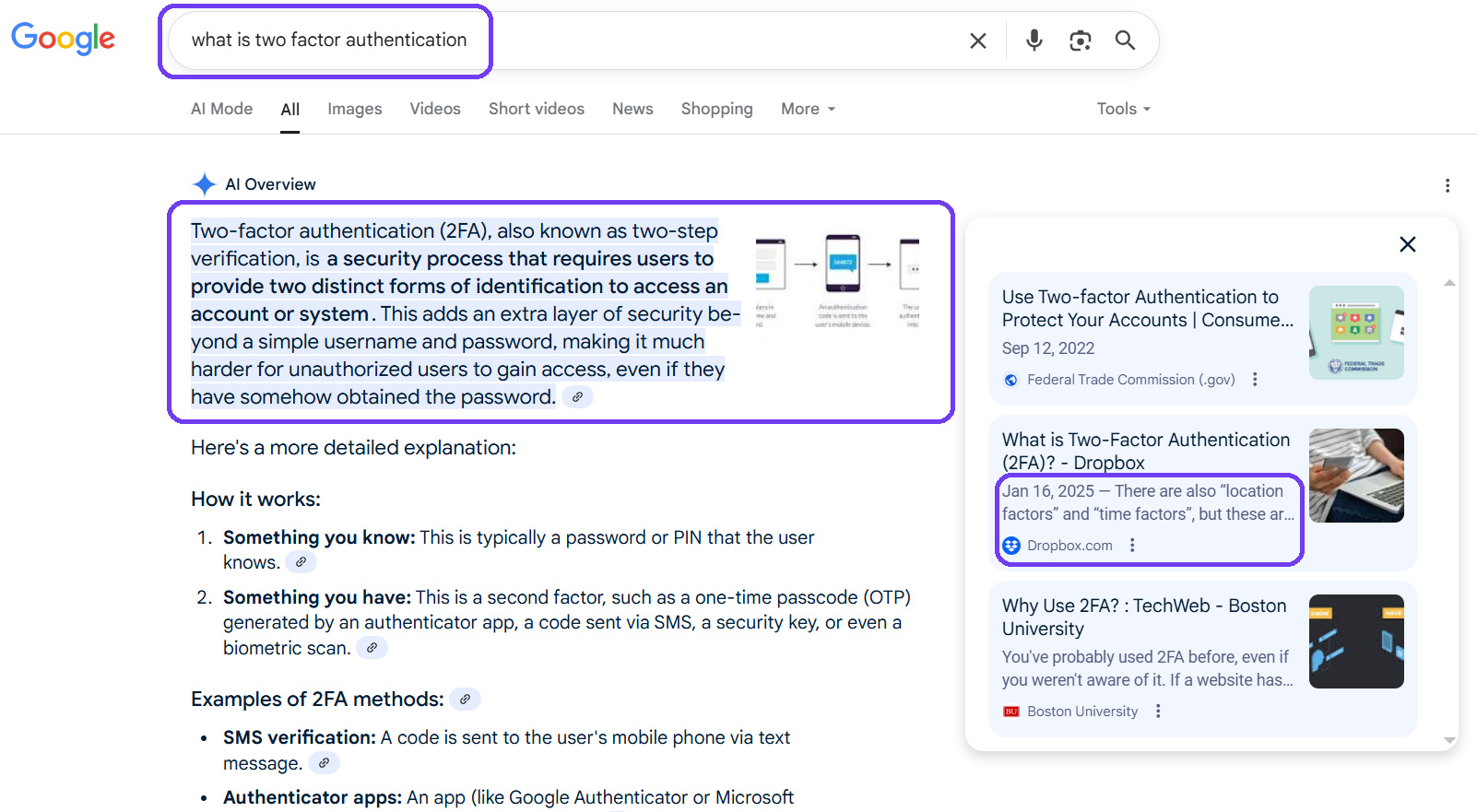
The text fragment I showed above is actually listed as a resource in AIO for the "What is two-factor authentication" search query.
Either way, make sure to prioritize text fragment identifiers closer to the top part of your webpages in particular. This would help with AI extractability and content relevance.
Common AEO challenges to expect
Although answer engine optimization may not seem as complex as long as you stick to the best practices mentioned, note that there are a few details you should pay particular attention to.
AEO is still not completely understood
Answer engine optimization is in its infancy—no one can 100% confirm whether most optimization methods guarantee positive results.
You may go through trial and error until you see what exactly works for you. Still, a user-first content strategy that satisfies user intent and provides direct answers is a great starting point.
AEO involves numerous platforms
In contrast to regular search engine optimization, where businesses would typically focus on one or two search engines, answer engine optimization is a lot more complex.
You'll have to focus on Google AIO, Bing Copilot, ChatGPT, Perplexity, and so on, to improve your online visibility. And that's excluding other factors like featured snippets and voice queries.
All these platforms differ in one way or another, so finding what works for each is particularly tricky. Consider taking a more methodical approach to answer engine optimization.
Focus on one answer engine at a time (like Google's AI Mode) until you find out what brings positive results. Once you do, move on to the next.
This can help prevent scope creep and generally contribute to a more focused strategy.
Limited options in performance tracking
As a combination of the other two factors, tracking performance can be quite tricky.
You have numerous platforms to optimize content for, but few dedicated tools to measure performance.
Plus, the Google Search Console Dashboard doesn't filter AI traffic from traditional SEO traffic.
Still, there are a few third-party tools to choose from. Ahrefs, SEMRush, and Surfer offers a dedicated AI tracker, for example.
Key takeaways
- Answer engine optimization involves optimizing content to provide direct answers. This boosts the chances of having your website cited and listed as a resource in AI-generated answers.
- Users are increasingly adopting answer engines as their go-to search tools. Answer engine optimization is crucial to maintain online visibility, website traffic, and revenue—you may risk experiencing a noticeable drop in these metrics otherwise.
- Answer engines leverage natural language processing and query context to compile information from various resources and generate relevant answers that satisfy user intent. Answer engines usually prioritize site authority when picking the resources to extract information from.
- Still, you can boost the chances of getting picked up by AI through a content strategy centered around user intent and LLM-friendly formatting.
- That means content that provides quick, direct answers to user queries should be your top priority.
- Also pay attention to formatting: include tables, lists, and bullet points, write descriptive headings (ideally question-based), and establish a logical content structure.
- Make sure details under your website's Schema match with your on-page copy to maintain strong trust signals.
- Experiment with text fragment identifiers to improve your content's extractability.
- AEO is still new, so there's no guarantee the current methods work 100% of the time—the sheer amount of platforms you have to optimize your content for, lack of algorithms transparency, and dedicated AI tracking tools are significant challenges.




